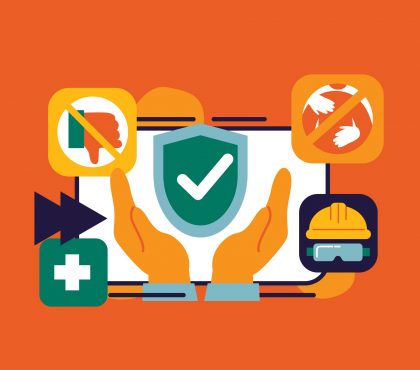Adopting animation in eLearning isn’t new since TedEd and KHAN Academy bring it to worldwide. However, it’s becoming as trendy as the most powerful visual storytelling tool to deliver knowledge to learners. Once you’ve come to the area of educational animation, let’s find out what are the latest animation trends in eLearning. After equipping enough necessary information, you will spot way to effectively put animation into your course.
Why is applying animation in eLearning a trend?
To answer this question, let’s explore how beneficial it is when a concept is communicated to learners through animated videos. And here they are, 3 typical reasons why people love to use animation in an online course:
- To be a visual-supporting tool:
It’s undeniable that animated video that consists of various beautiful visual and relatable illustrations does such a great help for our learning. How? Firstly, the imagery boosts our brains to process knowledge 60,000X faster than written words. Secondly, the visualized knowledge easily engages learners into lessons, keeps them stay focused. Finally, the information grasped under a visual-formed would be retained much longer and recalled better.
- To simplify complicated and abstract information:
Although our brain love visuals, sometimes it isn’t enough to explain complex or abstract concepts. So, that’s when animation comes to be a fabulous explainer. Specifically, animation is a perfect combination of visuals, motions, and voice-over. Indeed, visuals and motions help envision hard-to-see knowledge while voice-over adds a detailed explanation for the most complicated aspect of the concept.
- To tell a story of the lesson:
Another advantage of animation is storytelling. That is to say, this teaching method is appreciated because it starts with a background, to give the lesson a context and tell it as a story. Practically, it is usually found in primary teaching to teach kids. But rather, nowadays, people prefer the storytelling method to deliver soft skill training or complex one as mechanical knowledge.
Animation trends in eLearning
1. White-board animation: old but gold
White-board animation is an animated video created by simple hand drawing illustrations on a white background. Despite of the basic concept, this animation allows the video creator to add more creativity. Such as, instead of drawing a whole new illustration, they could combine with some photos or pictures as long as they share the same color palette. Besides the simple illustrations, the motion is also basic as it is easily generated by the computer.

For educators who want to transform text-based lesson to animated video for the first time, white-board usually comes to their mind as the best choice. Why? Because is it’s cheap but effective to deliver knowledge. Therefore, it’s cost-saving and worthwhile to test whether animation is good for their lesson. Besides, white-board is easy to create with a quick production time to fit the demand of producing a series of animation in a short time.
2. Motion graphic animation: the undying animation trend in eLearning
Most of the time, 2D motion graphic animation would be up there right at the top for educational purpose. Especially in eLearning scenario, motion graphic animated video is always top-of-mind. Because it could illustrate in various style for a wide range of field. From primary teaching to higher education, science processes or mental health problems. No matter how complex the content is, motion graphic animation could do it well.
For each topic, it will be a unique style that best suits the content. Moreover, you could get more if you work with an animation studio! To be more specific, their professional illustrators could ensure that the design could express your branding personalities in the video. For that, the design tyle will be more optimized to not only be eye-catching but also set a tone for the lesson.
Aside from the diverse in style, motion graphic is also better to apply storytelling method. In this aspect, the high-invested visual and smooth motion support a lot to tell the educational story. Though, going along with higher quality, motion graphic animation is more expensive to produce than white-board.
| Maybe you are interested in: » How much does an educational animation cost per minute: $30, $150 or $ 3000? |
3. Mix 2D & 3D animation: the new trend
One of the latest animation trends in eLearning recently is mixing 2D and 3D graphics for educational animation in eLearning. In eLearning, this application is used to explain topics with high accuracy as medical training for a better understanding. Also, in the engineering industry, 3D graphic is added into animated videos to show various dimension view to bring a better experience of observation.
So how 2D and 3D animation are combined in an eLearning video? Here is the answer:
- 3D graphic is in charge of explaining the most important concepts that need more realistic texture
- 2D graphic will cover the background and other supportive elements
- the animation step will take responsibility to keep the motion of 2D and 3D graphics balanced and consistent.
Obviously, if you have 3D materials in your video, the cost will be higher and the time will be longer. In other words, you will pay more to get more, it’s the enhanced visual experience for learners.
Want to leverage the power of animation in industries like finance, check out top compliance eLearning industry services.
The principles of applying educational animation
Feeling like you want to use educational animation, but can’t choose among fabulous animation trends in eLearning? Well, we can give you a hand!
Firstly, let we clear out that we already have an in-depth article that tells you what is best animation type for your online course, you could check it out. But, here are quick principles that you could keep in mind before creating an educational animation for your eLearning course.
Purpose of using animation:
- To create a whole video-based course: consider the budget
- To use animation as an additional material to improve eLearning course (for example, shift from traditional eLearning course to innovative one): choose motion graphic or mix 2D & 3D.
The reason is for better illustration and motion to fit the improving purpose
Kind of knowledge:
- Accounting (subjects that don’t require detailed or beautiful illustrations): whiteboard animation is the reasonable choice as it could have the power of storytelling and information conveying.
- Science (high requirements for design and accuracy): go with motion graphic, even 3D animation for better visualize the content
This interactive animation from a Permaculture Design Online Course that specializes in knowledge and practical solutions to develop sustainable ecosystems. Firstly, the course creator chose 2D animation as an effective visual aid to explain the complex effects of landscapes and climates. However, after a launching time, he found out that some difficult concepts need a more powerful visual-supporting tool to describe the details in the system. It’s time he came back to us to request a 3D animated video series.

- Soft skill training (use animation to avoid boredom add fun elements): use motion graphic with vibrant color but still keep the professional vibes
This example belongs to a training course for managers and leaders about executive coaching and team development. The animated video was created to be an additional material to improve learning outcomes of learners. Initially, they did choose whiteboard to keep the cost in the budget, but the result didn’t meet their expectation. Both content quality and branding awareness. After that, they tried 2D animation to better visualize the content and also add the personality of the company. And it worked! The 2D illustrations that follow the branding colors and style bring a new fun vibe for the training concept!
Conclusion
So that’s all about the animation trends in eLearning and how should you opt one for your online course. As you see, 2D motion graphic animation is always on top-of-mind as it never fell out of flavor. So if you want to create an educational animated video for your course, or need some advice from the professionals, feel free to contact us. As we are here to help you create more educational work to inspire learning!
Read Further:





